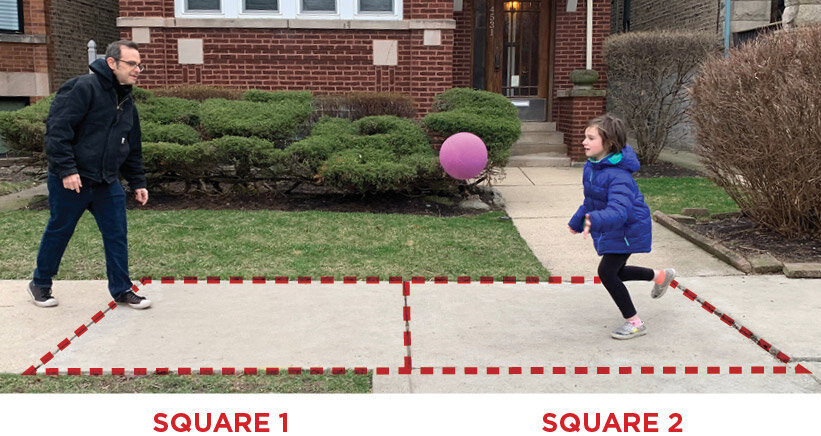Since we’ve been sheltering in place, we're starting to run out of things to do—what better time to get creative and visit old classics?
Today’s at home activity is a fun twist on the classic game 4-Square from Jon Resh, Creative Director at Chicago Children’s Museum.
By Jon Resh
In the midst of a global pandemic, one must find a glimmer of happiness wherever it may emerge. For me, it comes in the form of four specific words from my 9-year-old daughter, often uttered with colossal enthusiasm:
“LET’S PLAY 2-SQUARE!”
The revelry that is 2-square has taken hold of our home. This variation of 4-square, the classic schoolyard game, cuts the number of squares and players from four to two. The result is pretty much a sidewalk version of ping-pong (sans net and paddles)—and proves to be a perfect outdoor at-home game for families in these constraining, social-distancing times.
Simple, easy to learn, physically vigorous, playable in a variety of spaces, creative in its use of “royal rules” (see below), and flexible in duration (very short or long), 2-square is ideal for ages 7 and up — way up, in fact: the game is genuinely fun for adults too. Not sorta-boring-but-I’m-gonna-fake-it-because-my-kids-aren't-complaining fun—we’re talking actual legit fun for grownups.
2-square needs only three components: a ball, a flat space, and two people.
BALL:
The classic playground ball still works best, given its strong bounce and pliability. But any fairly large ball (soccer, basketball, etc.) that bounces well on concrete will do (though they may be a bit hard on kids’ hands).
FLAT SPACE:
Since the game must be played very close to home to adhere to social-distancing principles, any adjacent, relatively smooth sidewalk, driveway, or other flat, hard-surfaced area can serve as your 2-square court. The minimum width for each square is about five feet. If lines aren’t already in the ground to form two conjoined squares, draw them with chalk.
TWO PEOPLE (OR MORE):
Although only two players are needed, more players—many more!—can alternate or line up (as in 4-square). Or if your squares are big enough for team play, two players per square can work, similar to doubles tennis. Note: as of this writing, all players should be members of your household, in order to avoid exposure of the COVID-19 virus to or from others.
The rules are the same as 4-square, just distilled down to two squares. As a refresher, here are a few 4-square primers:
Quick overview by a narrator with a great Scottish accent (2 mins)
Extremely thorough written rules by Squarefour.org (many minutes)
An obvious difference from 4-square: with two players, there are only two positions — the “royal” (the server)* and the “ace” (the receiver). If the ace gets the royal out, the ace becomes royal, and the former royal then becomes ace. If there are more than two players, the next player in line takes the ace spot.
*Formerly called “king,” this position’s name has been updated to "royal” in some programs to be gender-neutral.
Other notable aspects of 2-square:
In accordance with social-distancing principles: when playing on a sidewalk, if a pedestrian approaches—walking their dog, jogging, etc.—stop the game and move six feet or more out of their way. Resume after they pass.
• A wide variety of ages can take part—as evidenced by this spry gentleman crushing oncoming whippersnappers.
Although usually an outside game, 2-square can be played in a room in the home or a garage (sans car) with a softer yet bouncy ball. Place masking tape on the floor to delineate the squares’ lines.
It’s a pretty viable game for cold-ish weather. We’ve been playing it with coats and hats in 40-something degree temperatures this spring and have had a blast.
If your 2-square area is parallel to a street (as our is): watch out for cars! If the ball bounces into the road, don't risk anybody’s safety by running blindly after it. Proceed with caution obviously—which also sets a great example for the kids you're playing with.
A developmental note: 4-square in schoolyards and playgrounds can get pretty intense, sometimes dominated by kids bending the rules or overlording the game’s hierarchy. Some children on the wrong end of such experiences may be shy about trying 2-square at home. With that in mind, frame your game as pure fun and adjust the level of competitiveness as appropriate. Added benefit: playing 2-square at home may give kids the confidence to try 4-square when they return to school.
Arguably the most fun and interesting facet of the game are the endless variations of “royal’s rules”: the server can dictate their preferred allowable plays by naming them before serving. These rules can vary from helpful to humorous to sheer anarchy. A few rules haven’t changed in a half-century — they’re the same rules I called as a kid. Below is a selected inventory of royal’s rules of the more playful variety (culled from Squarefour.org, various online P.E. sources, and my daughter’s untamable imagination).
So revel in your awesome 2-square adventure, don’t spike the ball too hard on your kids, and—for the love of humankind—wash your hands after.
CLASSIC ROYAL’S RULES (from when I was kid but are still in play):
Aerials: The ball can be hit in the air without bouncing first.
Animals: Each player must name a different animal when hitting the ball throughout play. If the player can’t name an animal or repeats one already named, they're out.
Double-Touch: Each player may hit the ball twice in the air after it's bounced once in their square (usually tapping it in the air once, then hitting it forward to another player). Choosing to double-touch is optional.
Line Do-Over: The game is stopped and restarted any time the ball hits any line.
Old Yak: The ball can be hit off an adjacent wall, ricocheting into another player’s square.
Watch My Feet: Server can serve far outside their square. Doing this can increase the speed, height, and/or force of the serve.
NEWER ROYAL’S RULES (i.e., including my daughter’s):
Baubles: Players can lightly bounce the ball between their hands (like juggling) before hitting it to another square.
Body Language: Players can use any part of their body to hit the ball.
Bomb: The server stops play and places the ball in the middle of the court and calls “Bomb.” All players must then race to touch the ball; the last one to touch is out.
Candy Machine: Players must dribble the ball for 3 bounces before hitting it to another player.
Chicken Feet: If a player hits another player below the knee with the ball, the player who hit the ball is out (not the player who's hit).
Downball: After the ball bounces in a player's square, that player must bounce it back in their own square first before it bounces into another player’s square.
Flamingo: The server chooses one leg that everyone must stand on. Players must play on one foot for the whole round.
Handy: Players can only play with one hand. The server chooses which hand.
Insanity: The server serves two balls, so that both balls are in play simultaneously. (These games tend to be short.)
Mini Michael Jordan: All players must remain in a squat position for the whole game.
Out-of-Pocket: Players must jump outside of their square after they hit the ball.
Pirate: Players must close one eye for the entire round and say something a pirate would say every time they hit the ball.
Popcorn: When receiving the ball, players must throw it into the air and clap a number of times before hitting it to another player, with each player increasing the subsequent clap number by one (I.e.., the first player claps once, the second player claps two times, the third player claps three times, etc.). If the player doesn’t clap enough times before hitting it to another player, they're out.
Robot: Players cannot bend their knees while playing and must make robot noises when they hit the ball.
Spinball: Players must spin around in a circle after they hit the ball.
Yeeet: Each player must yell “YEEET” when they hit the ball. If the player doesn’t, they're out.
Happy bouncing!


